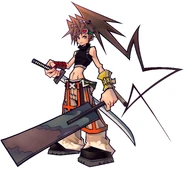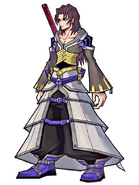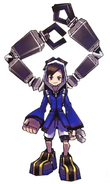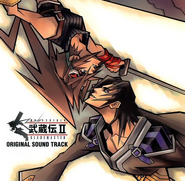Musashi: Samurai Legend, known in Japan as The Legend of Musashi II: Blade Master, is a third-person action game developed and published by Square Enix in 2005 for the PlayStation 2. Much like its predecessor, Brave Fencer Musashi, the game involves real-time combat in a 3D environment, and character designs by Tetsuya Nomura.
Plot[]
In an unnamed oceanic fantasy world, in the city of Antheum, carried by a magical beast called the Anthedon - a large skybound whale - exists the people known as the Mystics, who are peaceful magic users who wander the world. Years ago, Gandrake Enterprises, an energy technology megacorporation, came to power by their newfound invention of the Nebulium Engine, a remote perpetual energy device, allowing for the epoch of an era of technological innovation. However, despite their revolutionary technologies allowing the world to ease their standards of living and bring about a new age, Gandrake Enterprises is revealed to have come through power by corporate strong arming, intrigue, and coercion of the people by force, and their Nebulium Engine is revealed to be powered by the slave labor of magic users under their dominance.
Aware of the threat Gandrake Enterprises poses to her people, young Mystic Princess Mycella prays in the mystic Chamber of Rites to summon a hero who will save her world from their sinister designs. However, an attack lead by the Enterprises' Director of Administration, Rothschild, interrupts the ritual, which causes the summoned hero – Musashi – to land just a bit off course, and has Mycella captured by the corporation. He's found by old martial artist Master Mew, who immediately takes him under his wing. Once Musashi is ready, Master Mew sends him into the heart of evil Gandrake Enterprises to rescue the captured Princess and thereby save the world.
Unfortunately for Musashi, President Gandrake kidnaps the Princess again to further the plots of his evil corporation to excavate the world's supply of nebulite and use the Mystics power to power his nebulium engine. To stop Gandrake, and ensure that he can return to his world, Musashi goes in search of the five Maidens that protect the five magic swords that have been lost in order to restore power to a mythical creature known as the Anthedon, which houses the city of Antheum. Along the way, Musashi will have to smash his way through Gandrake Enterprises's endless swarms of killer robots and directors, as well as native monstrosities.
Characters[]
Note: English name or Japanese name
- Musashi: A young fencer summoned by Mycella to save Antheum from Gandrake Enterprises.
- Princess Mycella: Princess of the magical realm of Antheum; she's the one who summons Musashi at the beginning of the game. She is similar to Princess Fillet, from the first game.
- Five Maidens: The girls who help Musashi, by powering his sword with their abilities. They are similar to the Five Scrolls, from the first game.
- Burrini or Tamie: The Maiden of Earth. She is the daughter of Antheum's premier baker, Tunnbrod, and is a nature lover.
- Fontina or Ricotta: The Maiden of Water. A composed and scholarly girl who works in the Archives of Antheum.
- Mirabo and Maribo or Murol and Murolait: Twin sisters who are the Maidens of Fire. While young, their powers combined allow for them to complete their duties.
- Istara or Maquis: The Maiden of Wind. A swordswoman who watches over Picodon Jungle.
- Clochette: Possesses the power of Void.
- Master Mew or Mao: Old cat-like martial arts master. He discovers Musashi after the summoning deposits him in the new world, unconscious. Teaches Musashi the "Way of the Stray Cat". He is similar to Steward Ribson, from the first game.
- Gandrake: The evil president of Gandrake Enterprises. He is actually a former Samurai from Musashi's world, who's real name is Ganryu. He is similar to Kojiro, from the first game.
- Rothschild, Director of Administration: His success comes from his cold, cunning tactics. While trusted, no one knows what he's really thinking.
- Malbec or Albert, Director of Research and Development: An intelligent 10-year old boy. Creates the robot bosses that Musashi has to deal with in his encounters with Gandrake.
- Shiraz, Director of Intelligence: A disturbing villain. His position is suited to his frugal use of words. He can speak volumes with one lash of his razor-sharp tongue.
- Riesling or Tio, Director of Security: Not the brightest, and quick to anger. What he lacks in brains, he makes up in brawn. Frequently partners up with Glogg.
- Glogg or Ducasse, Director of Negotiations: His brute strength is unmatched, and he utilizes it in aggressive negotiations to secure his company's deals.
Themes[]
As an indirect sequel, Musashi: Samurai Legend attempts to showcase the teenage years of Musashi in the Musashiden series; compared to the classical European fantasy and Wild West steampunk inspired fusion world of Allucaneet of the first Brave Fencer Musashi that presents a more whimsical storybook like otherworldly realm, Samurai Legend appears to try to capture a more contemporary and modernesque feel through a combination of anime and manga stylings, a magic versus technology turn of the age time period akin to Final Fantasy VII, and an overall element of "extreme" and "radical" from 1990s and early 2000s American action cartoons and youth media.
The unnamed world of Samurai Legend in this case is akin to the Pacific Rim or even seaside culture in general, an oceanic world of islands separated by the sea, with the Mystics showing a deep practice of Polynesian, Grecian, and even Shinto inspired culture and shamanism. As the inclusion of The Surf Coasters indicates, there is also a strong undercurrent of surf culture, despite the lack of overall surfing portrayed in the game, although this may be deliberate as a throwback to classic Americana South California beach party movies of the 1960s, which focused more on the human element of melodrama than actual surfing as the main draw itself. Possibly of some relation with Kingdom Hearts, which character designer and producer Tetsuya Nomura also is in charge of, the lead female star of the first defining movie Beach Party, Annette Funicello, was also a Mickey Mouse Club Mouseketeer, and became famously associated with the genre ever since her debut.
Antheum's population, aesthetic, and overall atmosphere is evocative of modern day Southern California, which has long been said to be the second "crossroads of the world", featuring a greater diversity of people and ethnicities coming together in this installment, and their constant migration of their world may hearken to the surfer culture inspired concept of the "endless summer", where one is able to chase the paradisaical summer season "endlessly" throughout the world's beaches with the right resources. The Mystics being a magical people may also hearken to "the magic of California", a term used to describe the state's almost indescribable attracting force that has come to make it the world famous location that it is, or simply being to refer to being home to the California Academy of Magic, or to its inspired namesake, from the Amazon warrior queen Lady Califia, who lead her own army of amazons on her mythical island of California, and was used to describe an untamed and untouched land of wonder and abundance. Alternately, Antheum is evocative of Miami, "The Magic City", and the Anthedon may be a play on its state of Florida, as Anthedon in Greek translates to "flowery", much as Florida is Spanish for "flower". Antheum's political and autonomous struggles against Gandrake Enterprises are further evocative of Hawaii's struggle in the turn of the 20th Century to remain independent as its own kingdom in the face of United States annexation and underhanded influence by the American sugar plantation and manufacturing industry.
In the original script of Samurai Legend, the Anthedon is instead named the "God Beast". Whales within oceanic and seafaring cultures long have regarded the creatures as divine beings; in Polynesian culture, whales are said to be primordial beasts of great mana who over saw the creation of the world; the Maori regard whales as the descendant of the sea goddess Tangaroa and as the messengers who signaled the lands of New Zealand to settle upon; in China, Yu Kiang was a flying whale that ruled the seas before the Dragon King; in Japan, whales are regarded as shintai or an embodiment of the gods, specifically that of Ebisu, one of the Lucky Seven Gods who lords over fishing, and were revered in sacrifice in times of scarcity; in Biblical scripture, the tale of Jonah comes to mind, in where he was swallowed up by a whale commanded by God upon defying his destiny, and relented upon accepting his role in God's will. In Greek mythology, Anthedon is said to be the father of Glaucus, a mortal who became a god through ingesting a magical herb grown by the shedding of ichor, the blood of the gods, and was the guardian deity of fishermen and prophecy, while whales are identified with the mythical creatures known as the aspidochelone, being massive sea creatures who carry landmass large enough to be mistaken for islands.
Alternately, a strong undercurrent of Ancient Grecian fantasy culture may be interpreted from this, as prophecy, divining, and even basic estimation of future events appear to play a strong role in Mystic culture, akin to how the city of Delphi was turned to for its female oracles, journeying by boat was not uncommon throughout the Grecian archipelago, and Ancient Greek democracy served as the inspiration for the constitutions and politics of the United States. Even the introduction of high technological advancement is not out of place for the world of Musashi Samurai Legend; records tell of how even machinations and robots existed in Ancient Greece, from the guardian metal dogs of King Alkinous, to the progenitor mecha like men of the Colossus of Rhodes, and Talos, created by Hephaestus, the God of Blacksmithing, and to how advanced infrastructure was incorporated in many ancient cities. Nebulite's color and purpose in this instance is evocative of ichor, which is said to be the divine blood of the gods and demigods upon consuming their divine mainstays of ambrosia and nectar, and was incorporated as the fuel source for machinations, especially for the Colossus of Rhodes. Samurai Legend's world is further evocative of the legendary place known as the Fortunate Isles, which in Greek and European mythology are islands that were said to exist far west in the seas beyond Hades, and where heroes lived comfortably in paradisaical conditions, with the exceptions of the occasional monster coming out from the sea, and are believed to be Atlantic islands like the Canary Islands and Bermuda.
Within Musashiden's genre of isekai, Samurai Legend comes to draw more upon Hollywood movies, specifically to the 1980s Ninja movie boom, with movies such as American Ninja and Enter the Ninja; this is especially exemplified with the Ninjaroid enemies Gandrake Enterprises utilizes for its excursions and underhanded ploys for power. Within these movies, they often tell of a journeying wandering ninja warrior who enters into foreign lands and comes to gain knowledge and wisdom, as well as commit themselves to the destruction of evil that ails the inhabitants by their honor of virtue, and these movies tend to have exotic but rather tumultuous settings with overruling villainous elements drawn to the allure of unrestrained power. Often, the ninja hero will have to clash against an evil use of ninjutsu used by said villains, be it ninja mercenaries who seek power by any means necessary, the employment of ninja as their own merciless personal army, or even perverting the way of the ninja with unnatural or corrupt methods, and stop evil from entering the way of the ninja as well. While the ways of the ninja are popularly seen as diametrically opposed to samurai, real life history and study tells that they are two sides the same coin, following ways of honor and valor into combat regardless of battle being either duels or sabotage. In Miyamoto Musashi's martial arts, even he was known to utilize trickery and to use his opponent's weaknesses against them, from cornering foes in poor positions and disadvantageous conditions, mixing up his timing to throw off his foe's pacing, and even utilized shuriken-jutsu, from throwing his swords to secondhand weapons, to attack from outside his range and catch his foes off guard.
In the mythos of Miyamoto Musashi, it was not uncommon to hear him be recanted in tall tales, folklore, urban legends passed from one samurai to the next, and even portrayed in the earliest forms of manga for his undertakings and quests throughout Japan. While prints of him fighting fantastical monsters and beasts popularly exist of him, from fighting tengu to nue and even large man eating bats, one of them portrayed him riding on a whale on the open seas, doing battle with the massive beast. Of his most famous battle with Sasaki Kojiro of the Ganryu school, in where he fought with a large oar to close the distance with his famous rival, the battle was set at the beach of Ganryujima Island out on the Shimonoseki Straights, and Musashi at the battle's end was said to have used the receding tide to help his escape.
Finally, his short lived romance with Princess Mycella also draws upon the lesser known elements of Musashi's personal life. While it is commonly accepted that Musashi forgone romance throughout his life for pursuit of his warrior's craft and adopted children, even the affairs of romance is a murky topic, as records on the contrary tell of him courting women who bore his children.















